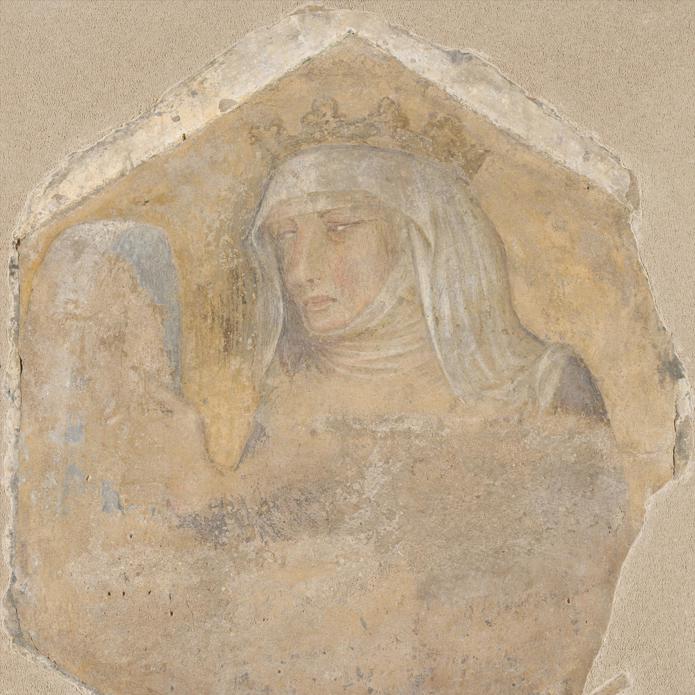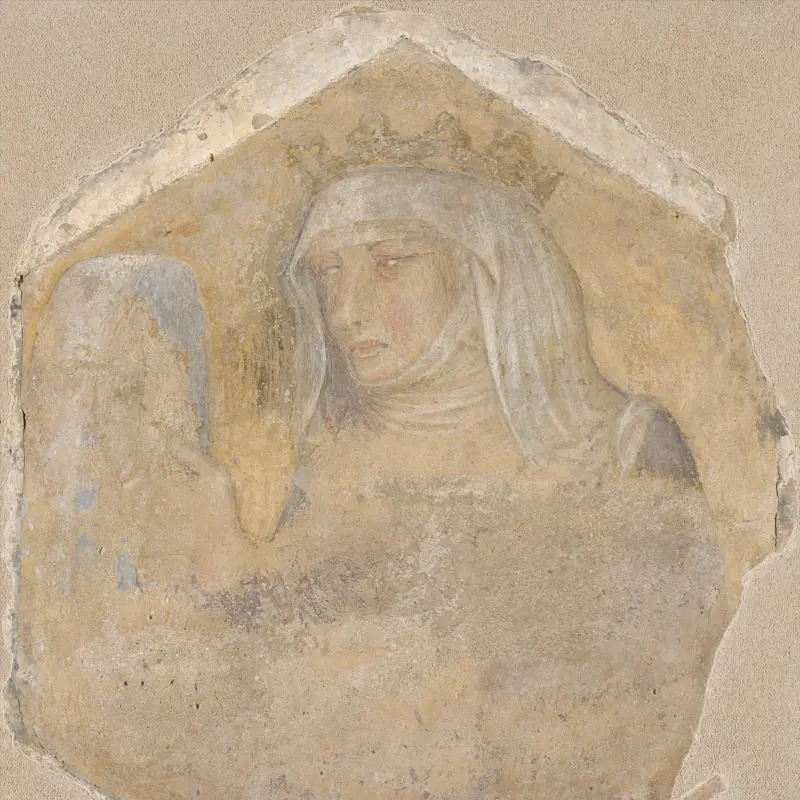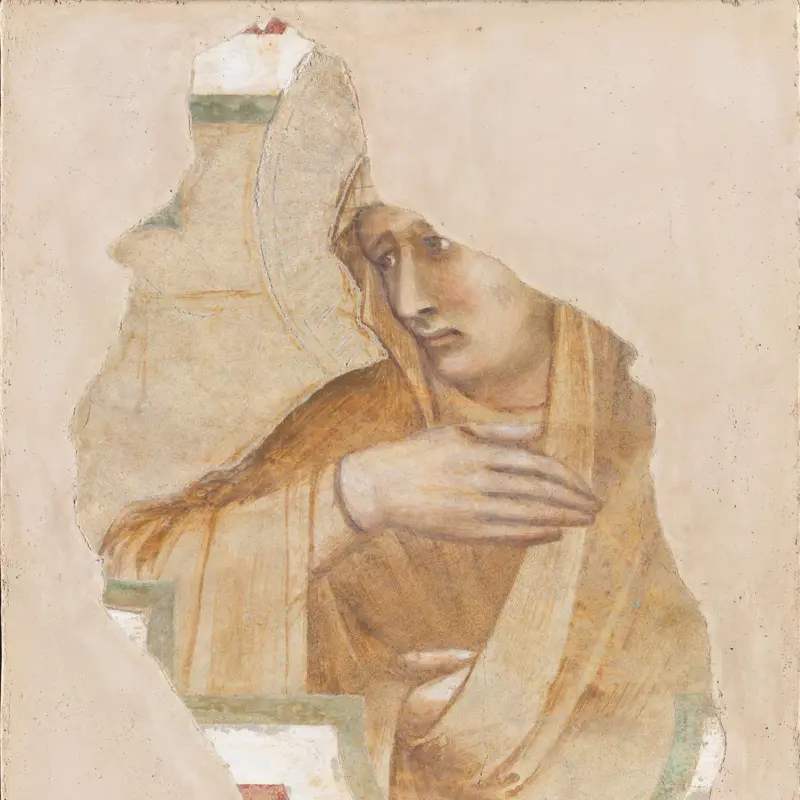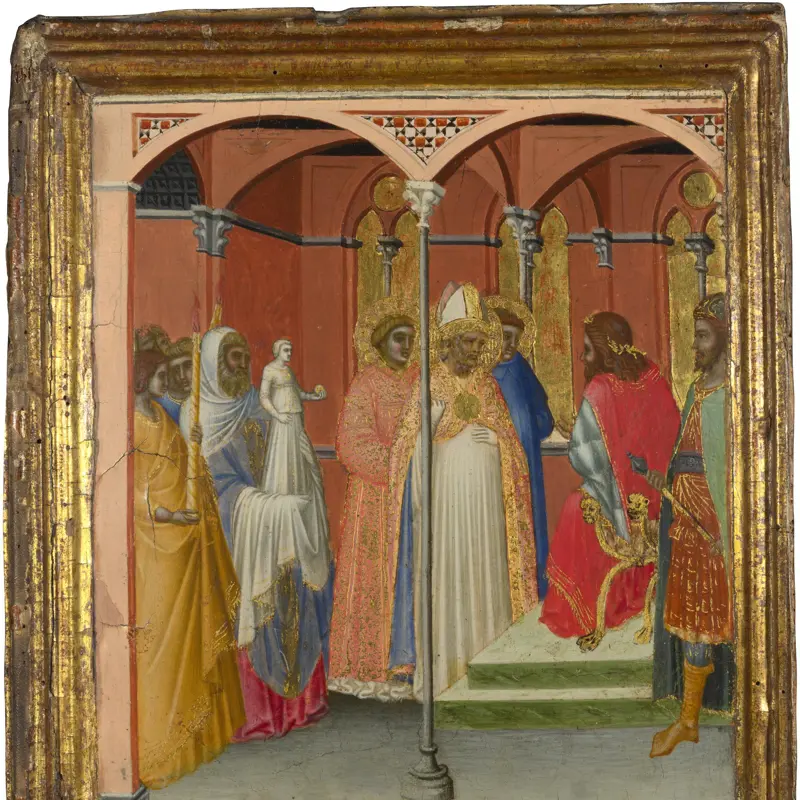Pietro Lorenzetti and Workshop, 'A Female Saint', 1320s
About the work
Overview
The upper layers of paint in the draperies are faded so that you can see the underdrawing – or sinopia – beneath. Traces of paint reveal that the draperies were originally blue. The figure’s pose – she recoils in fear, drawing her hand to her breast – is similar to images of the Virgin receiving the news of that she would bear the Son of God at the Annunciation.
This fragment of fresco once formed part of the border decoration of a large wall painting in the chapter house of San Francesco, Siena. It was removed in the nineteenth century and purchased by the archaeologist and National Gallery trustee, Austen Henry Layard. As an example of the work of the workshop of the Sienese painter Pietro Lorenzetti, who, with his brother, Ambrogio, decorated several important religious and public buildings in Siena with frescoes, it was a desirable object despite its poor condition. Layard was a member of the Arundel Society founded to document and preserve Italian frescoes.
Key facts
Details
- Full title
- A Female Saint (the Annunciate Virgin or one of the Marys?)
- Artist
- Pietro Lorenzetti and Workshop
- Artist dates
- Active possibly 1306, died probably 1348
- Part of the series
- Pietro Lorenzetti Fresco Fragments
- Date made
- 1320s
- Medium and support
- Fresco with areas of secco
- Dimensions
- 39 × 30 cm
- Acquisition credit
- Layard Bequest, 1916
- Inventory number
- NG3072
- Location
- Not on display
- Collection
- Main Collection
- Previous owners
Provenance
Additional information
Text extracted from the ‘Provenance’ section of the catalogue entry in Dillian Gordon, ‘National Gallery Catalogues: The Italian Paintings before 1400’, London 2011; for further information, see the full catalogue entry.
Exhibition history
-
2017Ambrogio LorenzettiComplesso Museale Santa Maria della Scala22 October 2017 - 8 April 2018
Bibliography
-
1951Davies, Martin, National Gallery Catalogues: The Earlier Italian Schools, London 1951
-
1986Davies, Martin, National Gallery Catalogues: The Earlier Italian Schools, revised edn, London 1986
-
1988Gordon, Dillian, National Gallery Catalogues: The Early Italian Schools before 1400, revised edn, London 1988
-
2001
C. Baker and T. Henry, The National Gallery: Complete Illustrated Catalogue, London 2001
-
2011Gordon, Dillian, National Gallery Catalogues: The Italian Paintings before 1400, London 2011
-
2024J. Cannon, C. Campbell and S. Wolohojian (eds), Siena: The Rise of Painting 1300-1350 (exh. cat. Metropolitan Museum of Art; National Gallery, London), London 2024
About this record
If you know more about this work or have spotted an error, please contact us. Please note that exhibition histories are listed from 2009 onwards. Bibliographies may not be complete; more comprehensive information is available in the National Gallery Library.
Images
About the series: Pietro Lorenzetti Fresco Fragments

Overview
These two fragments of frescoes (which were painted directly onto a freshly plastered wall) come from the Sienese convent church of San Francesco. They were part of the border decoration of larger fresco paintings on the walls of the church’s chapter house. By the time they were discovered in the mid-nineteenth century, the chapter house had been converted into a blacksmith’s workshop and the frescoes had been covered with whitewash.
Once restored, the larger surviving frescoes were moved to chapels in the church itself. These fragments appear almost monochrome as their removal from the wall damaged the coloured surface painting, revealing the brownish preparatory design below.



